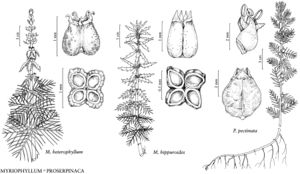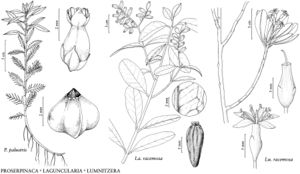Proserpinaca
Sp. Pl. 1: 88. 1753.
| Taxon | Illustrator ⠉ | |
|---|---|---|
 | Myriophyllum heterophyllum Myriophyllum hippuroides Proserpinaca pectinata | |
 | Proserpinaca palustris Laguncularia racemosa Lumnitzera racemosa |
Herbs, monoecious, aquatic or semiaquatic [terrestrial]; with taproot or fibrous and, often, adventitious nodal roots. Rhizomes present. Stems creeping to erect [decumbent to ascending], terete, unbranched proximally, often branched distally, glabrous or ± punctate, often with scattered, black, ascidiate trichomes. Turions absent. Leaves submersed or emersed, alternate, homomorphic, dimorphic, or heteromorphic; sessile or petiolate; blade entire or lobed to pinnatifid or pectinate, margins entire or serrate; with trichomes in axils of leaves and scattered on surfaces. Inflorescences usually racemes or cymes, rarely dichasia, in axils of unreduced, emersed leaves; bracteoles paired, alternate, opposite subtending emersed leaf, secondary and tertiary bracteoles sometimes present; flowers bisexual. Flowers 3 (or 4) -merous; petals caducous, rudimentary, sometimes absent; stamens 3, in 1 antisepalous whorl; ovary 3 (or 4) -locular. Fruit a nutlet, tan to brown, ovoid, obturbinate, or pyramidal, transversely 3-angled, with acute angles or shallowly 3-lobed, faces concave, flat, or curvilinear, without ridges, surfaces smooth, rugose, papillate, or tuberculate. x = 7.
Distribution
North America, Mexico, West Indies, Bermuda, Central America, South America
Discussion
Species ca. 2 (2 in the flora).
Selected References
None.
Lower Taxa
Key
| 1 | Leaves homomorphic, pectinate, elliptic to ovate in outline. | Proserpinaca pectinata |
| 1 | Leaves dimorphic to heteromorphic, submersed leaves pectinate, ovate, elliptic, obovate, or trullate in outline, emersed leaves pinnatifid to shallowly lobed to minutely serrate, lanceolate, narrowly elliptic, oblanceolate, spatulate, or obovate in outline. | Proserpinaca palustris |